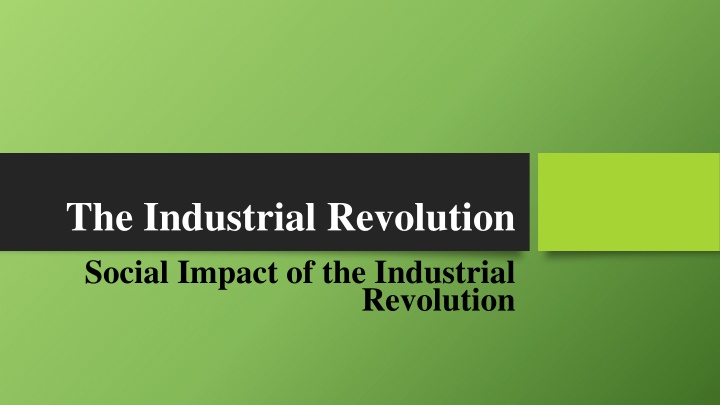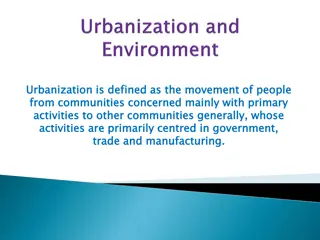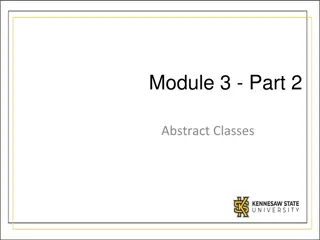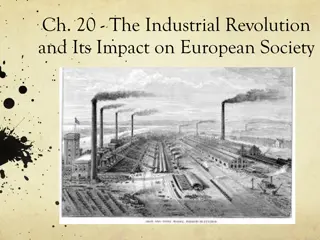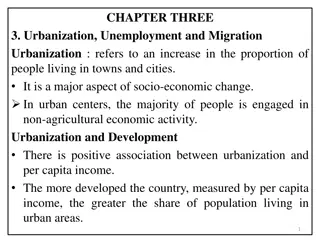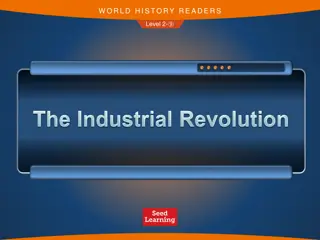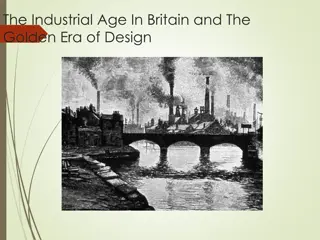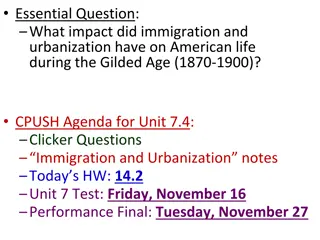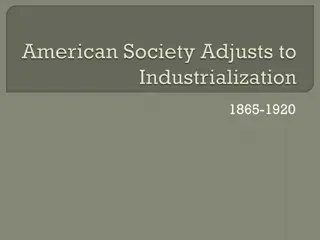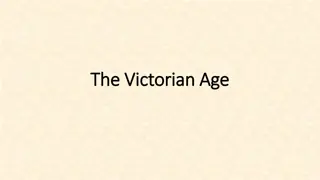Social Impact of the Industrial Revolution: Living Conditions, Urbanization, and New Social Classes
The Industrial Revolution had a profound social impact, bringing contrasting living conditions for entrepreneurs and workers. While entrepreneurs reaped riches, workers faced poverty and harsh living conditions. Urbanization accelerated as people moved to cities for work, leading to the growth of new social classes like the middle class. Despite tough working conditions, a sense of community developed among the working class.
Download Presentation

Please find below an Image/Link to download the presentation.
The content on the website is provided AS IS for your information and personal use only. It may not be sold, licensed, or shared on other websites without obtaining consent from the author.If you encounter any issues during the download, it is possible that the publisher has removed the file from their server.
You are allowed to download the files provided on this website for personal or commercial use, subject to the condition that they are used lawfully. All files are the property of their respective owners.
The content on the website is provided AS IS for your information and personal use only. It may not be sold, licensed, or shared on other websites without obtaining consent from the author.
E N D
Presentation Transcript
The Industrial Revolution Social Impact of the Industrial Revolution
Living Conditions Industrial brought great riches to most entrepreneurs For the workers the industrial age brought poverty and harsh living conditions Eventually reforms would be enacted in Europe and America to curb many of the worse abuses
Living Conditions As standards of living increased, people at all levels benefited from industrialization Until that time, workers faced dangerous working conditions, unsafe housing, and unrelenting poverty
Living in Industrial Cities Industrial Revolution brought rapid urbanization (the movement of people to cities) Changes in farming, soaring population, and demand for workers led people to move from farms to cities Cities grew up around mines and factories Visitors to cities described cloud of coal vapor, the noise of steam engines, and the stench of the rivers
New Social Classes Industrial Revolution created a new middle class along with the working class Middle class owned and operated the new factories, mines, etc. and their standard of living was much more comfortable than the working class Working class faced tough working conditions, however they began to develop a sense of community
The Industrial Middle Class Those who benefited most from the Industrial Revolution were the entrepreneurs who set it in motion The Industrial Revolution created the bourgeoisie who came from varied backgrounds Merchants Skilled artisans Rags to riches individuals
The Industrial Middle Class Middle class families lived in well-furnished, spacious homes with a ready supply of water, wore fancy clothing and ate well Took pride in their hard work and determination to get ahead Women of the middle class focused on raising their children rather than working
The Industrial Working Class Working class struggled to survive in foul-smelling slums Most working class lived in tenements (multistory buildings divided into apartments) Had no running water, sewage, or sanitation systems Led to spread of diseases such as cholera
Workers Stage Protests Originally labor unions (workers organizations) were illegal, but still met in secret Wished to enact worker reforms such as increased pay despite having no political power First labor riots occurred in England between 1811 to 1813
Workers Stage Protests Groups of textile workers called the Luddites resisted the labor-saving machines that were taking their jobs Wearing masks and operating at night, they smashed textile machines and burned factories Luddites had widespread support among working class
Comfort in Religion Many working-class people found comfort in religion, especially in Methodism John Wesley founded the Methodist movement in the mid- 1700s and encouraged his followers to improve themselves by adopting sober, moral ways
Comfort in Religion Methodism taught a message of forgiveness for sin and a better life to come Took the message of hope to the slums where they tried to rekindle hope among the working poor Methodists helped channel worker anger away from revolution and toward reform
Factory Life Compared to farm life and cottage industry where workers could work at their own pace, factories forced workers to face rigid schedules set by the factory whistle Shifts lasted 12 to 16 hours six or seven days a week and workers could only take breaks when given permission
Factory Life Workers suffered accidents from machines with no safety devices or breathed in air filled with lint in textile mills Workers who became sick or injured lost their jobs Factory work created double burden for women: taking women out of their homes for 12 hours and having to feed and clothe their families, clean, and cope with sickness and injury
Harsh Life in the Mines The increased demand for iron and coal increased the need for miners Miners paid more than factory workers, working conditions even worse Worked in the darkness and coal dust destroyed their lungs
Harsh Life in the Mines Constant dangers of explosions, flooding, and collapsing tunnels Women and children forced to cart heavy loads of coal, sometimes on all fours, and climbed ladders carrying heavy baskets of coal
Children Have Dangerous Jobs Factories and mines often hired children, some of which began working at age 7 or 8 Children faced extremely harsh working conditions due to their nimble fingers and being quick Parents accepted the idea of child labor because children had worked on the farm Wages children earned necessary to keep families from starving
Children Have Dangerous Jobs Child labor laws factory acts were passed in early 1800s Reduced child workday to 12 hours Removed children under 8 or 9 from working in cotton mills Laws usually not enforced, forcing British lawmakers to form inspection teams to ensure mines and factories obeying the laws
Results of Industrialization People have debated whether the Industrial Revolution was a blessing or a curse Early industrial age brought terrible hardships, however reformers pressed for laws to improve working conditions Eventually unions allowed to bargain and working-class
Results of Industrialization Despite social problems, Industrial Revolution did have positive effects As demand for goods rose, new factories built offering more people jobs Wages rose, giving workers enough money to pay for rent, food, plus entertainment As costs for railroads fell, more people began traveling farther
